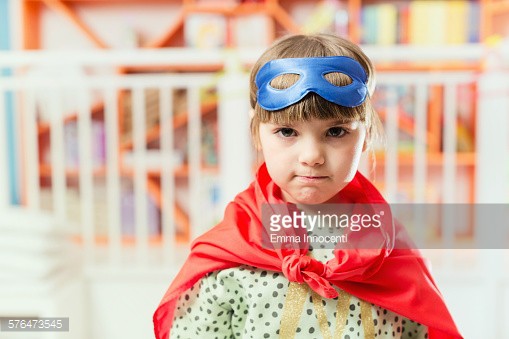Step aside, Elsa. It’s not your year. For the first time in forever, Halloween 2016 is the year of the superhero.
After 11 years of dominance, the princess costume has been dethroned as the most popular Halloween costume. The results of a survey from the National Retail Federation showed that superhero costumes had seized the top spot and come in as the most popular costume among children.
The popularity of superhero costumes is nothing new. Batman, Superman, and Spiderman costumes have long been a staple of Halloween stores. But surging past princess costumes this year required broader participation: namely, among girls.
This year’s cast of superhero costumes includes a heavy dose of female characters ranging from the CW’s Supergirl to Black Widow of The Avengers movies to super-villain Harley Quinn from the Suicide Squad. The heavy load of recent comic book-inspired movies and TV shows, many of which feature prominent female characters, contributed significantly to ending the reign of the princess costume as the number one.
This topic strikes close to home. I have three nieces under the age of 3, and there was much deliberation over their costumes.
*****
A TED Talk entitled “Bring on the Female Superhero!” helped bring to my attention to the importance of this shift in popularity among costumes. This TED talk, which was published last year, doesn’t predict the success of this year’s Halloween costume takeover by superheroes. Rather it examines the way the female superhero has consistently been forced to take a backseat to its male counterpart, especially in merchandising.
In the talk, Dr. Christopher Bell discusses the impact of living in a 100% media-saturated society. “Media,” he says, “don’t tell us what to think. Media tell us what to think about. They control the conversation.” He uses the example of Disney, which has made most of its money selling princesses (and princess costumes) to girls. When Disney bought LucasFilms in 2012, they flooded their stores with Star Wars merchandise. But there was one character suspiciously absent from all the products they were selling: Princess Leia. And why was she missing? Because she doesn’t fit the Disney princess mold.
The Disney princess mold is the one that we all know and that my nieces love. It’s Elsa and Cinderella. It’s focused on classical conceptions of female beauty: long hair, flowing dresses. “How pretty!” my oldest niece remarks every time Frozen comes on. Princess Leia, with her simple outfit and tied-up hair, doesn’t fit.
Dr. Bell continues his examples with Disney’s purchase of Marvel in 2009. Since then, they’ve produced superhero movies like Guardians of the Galaxy and The Avengers series, which include prominent female characters. Yet, as Dr. Bell recounts, he couldn’t find a single piece of merchandise with the female characters included. Most striking is the example of a play set called the “Cycle Blast Quinjet,” where Captain America rides a motorcycle out of a moving jet. The striking part? In the movie, it’s not Captain America riding out of the jet, but the female character Black Widow. In the toy, as Dr. Bell laments, “not only has she been erased, but she has been replaced by a male figure.”
In response to the omissions of female characters from merchandise, millions have taken to social media by protesting the absence of Princess Leia in Star Wars gear, Gamora from Guardians of the Galaxy, and Black Widow from The Avengers. It seems that this pushback is starting to have an effect. While I haven’t been searching through Disney stores, a Google search of children’s Halloween costumes yields results for all three of these characters. And not coincidentally, superheroes have overtaken princesses as the top seller this year.
*****
I can’t help but reflect on the tremendous impact that this has on young girls. When I think about my nieces, I can see how much they are influenced by what they see and hear. I am worried about the way society is teaching them to think, act, and look. I am worried about the way media like Disney are teaching them. Heck, I am worried about the way that I am teaching them.
Much like a kid staring at Elsa on the screen, my first reaction with every picture I see of my nieces is, “how cute!!!” And I am not alone in thinking this. When my brother or sister-in-law post a photo on Facebook, it is inevitably followed by a flood of comments along this vein.
After listening to Dr. Bell’s TED Talk, I can’t help but wonder, “what are we teaching these girls?” How are we teaching them to gain our attention and praise? Is it by the way they look and dress? Are we valuing appearance more than behavior, effort, or attitude? Disney might be teaching children that a girl is supposed to be a princess and not a superhero, but how am I affirming the same mentality?
Comments about a kid’s appearance are well intended: I know that I mean well when I gush about how cute they look sitting in a wagon wearing bonnet hats. Or dressed as Disney princesses. But while it’s easy for me to be critical of Disney for what seems like deliberate manipulation, I also need to be more self-aware of the ways that I am reinforcing (or even forcing) gender norms upon my own nieces.
I want to be affirming to my nieces, and I want them to feel loved. But I don’t want them to feel that this love and affirmation is just based on how they look. So instead of always reverting to comments like “how cute!,” I need to spend more time complimenting them for playing together well, for sharing, for being forgiving, and for problem solving. If I want them to feel loved for good attitudes and good effort, it starts with my own words and actions. I need to show them that I care about the goodness that’s inside of them, not outside. For who they are more than how they look.
So what’s in a Halloween costume? It’s much more than just colored fabrics and repurposed clothing. What is promoted and sold to children, including merchandise and costumes, shapes their view of themselves and the world. And it also comes back to us. How we talk to children and give them affirmation matters, too.
Today my nieces, along with children across the country, are dressing up in Halloween costumes. As usual, there will be beautiful princesses and fierce superheroes. This year, you will also see plenty of fierce princesses and beautiful superheroes. And that’s a good thing.


